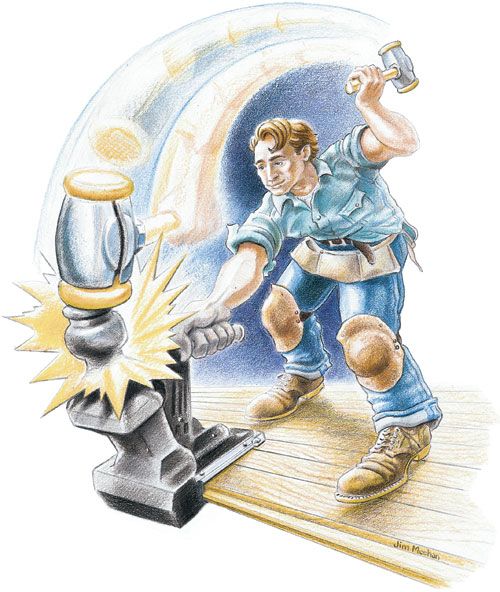Finding the Rhythm
Great moments in building history: When working, remember a Zen monk's words, “Don’t do any task in order to get it over with.”

I am replacing the tongue-and-groove boards on my back porch. I have laid a new board across the joists and am holding the floor nailer with my left hand and the 3-lb. hammer with my right. I have used this tool before and know I have to wallop the head of the floor nailer if it is to sink the nail below the surface of the board. I swing the hammer and at the last second hope the nail goes in straight. This thought is enough to deflect the hammer from a solid hit.
I lift the floor nailer to see the nail protruding a quarter-inch above the board. There is no sense cursing. I pull out the nail and reposition the floor nailer, this time thinking it will be a long day if I have to sink each nail twice. This experience is not new for me, and I know that using the floor nailer requires a clear mind at a crucial moment. As the day progresses, I remind myself to concentrate, not to hurry. I recall but ignore a Zen monk’s words, “Don’t do any task in order to get it over with.”
There are times when concentration is unimportant and unnecessary—as when I commute to the school where I teach, my day job that makes it both possible and necessary for me to replace my own porch floors. During this 45-minute drive, I plan the day, solve problems, prepare for classes and dream of buying a new tool—a dream I replay whenever I want to feel good. If I spend a lot of time daydreaming, however, even during routine tasks, I can’t concentrate when I need to. So sometimes I pay attention to the road and to other cars as an exercise in self-discipline. I find these times enriching—for the moment and for the lingering habit of awareness. I also feel less tired when I pay attention than when I daydream.
I have watched myself teach, and I am ashamed to say that at times I have hurried through class, eager to get out, or have been plagued with fears of students not learning. Students are more forgiving of my momentary distractions than the floor nailer, but the results are the same. For instance, when my directions in class are unclear, there is conflict. When my answers are muddled, there is confusion. No amount of planning can prepare me for every encounter in the classroom, but a disciplined mind capable of being aware helps me teach.
By early afternoon I know I will finish the porch floor before dark, and from the continuing sunshine, the usual afternoon thunderstorm seems unlikely. I am falling into a rhythm with the floor nailer. I notice that I do not flinch when the hammer hits the nailer. I focus my eyes on a small scratch at the center of the 2-in. dia. nailer head. My mind stays clear for a second or two after I strike the nailer. I extend the time on both ends when my concentration is steady—at the beginning as I inhale and lift the hammer above my head, and at the end until I move to the next board. During this time of concentration, I feel calm.
In my teaching I am surrounded by amazingly articulate people. I swim in a world of words. The floor nailer, however, doesn’t work with words. In fact, words get in the way. The moments when I can suspend inner speech to strike the floor nailer clean are like opening a screen door. The door will shut if I open it an inch or a foot. But it will pause open if I push it to 90°, and it will stay open if I push it to 180°. To master the floor nailer, I have to suspend language as long as I can to keep it from interrupting the hammer’s swing.
By four o’clock I no longer feel as if I am holding the hammer and hitting the floor nailer. Focusing on the point of the hammer strike has become unconscious and automatic. It is as if I have moved through the distance between me and the floor nailer and I am now at the floor nailer. I know that no wind is passing my face as I speed through this short space, but it feels like it. My hand and arm muscles are relaxed even though they exert enough force to drive the nail below the surface of the board. Although my body takes up more space than the floor nailer, I am part of the floor nailer. I feel no boundaries.
By 4:45 I am finished, and I return the floor nailer to the rental shop. The shop owner tells me the story of three men who returned their floor nailer after a few hours, cursing because it chewed up the grooves of their boards. We laugh. I do not mention that when I first used the floor nailer a few years ago, I too tried to drive the nail through the groove of the board rather than the tongue. This story makes me feel as if I have been accepted into a brotherhood of floor nailers.
—Donald R. Gallehr, Warrenton, Virginia
Drawing by: Jim Meehan
Fine Homebuilding Recommended Products
Fine Homebuilding receives a commission for items purchased through links on this site, including Amazon Associates and other affiliate advertising programs.

Affordable IR Camera

Handy Heat Gun

Reliable Crimp Connectors






















